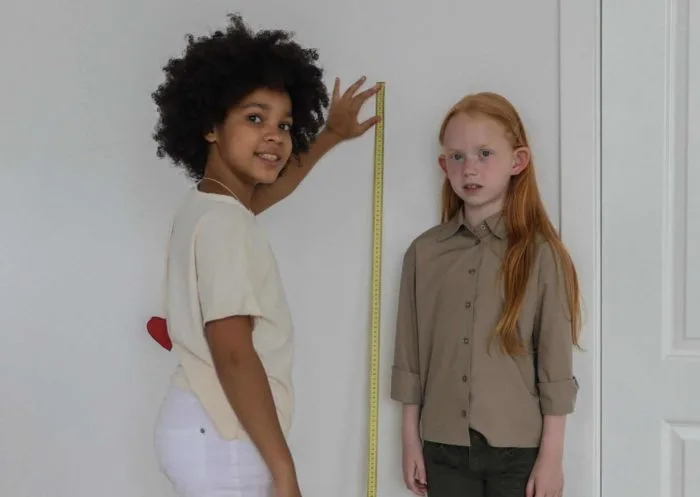I have experienced and watched the changes that come with adolescence in my teenage son.
Even though growth spurt symptoms are different for every child, some things stay the same.
Signs of growth spurts in teenagers include starting puberty, clothes are too small, shoes don’t fit, prominent joints, clumsiness, hair growth, body shape changes, body odor, change in voice, emotional changes, increasing appetite, angry teens, pimples, and sleep changes.
In this article, you’ll learn when a growth spurt starts, how long it lasts, and how to spot signs that it is happening.
- Signs And Symptoms Of Growth Spurts In Teenagers
- What is a Growth Spurt?
- What Causes Growth Spurt In Teens?
- When Do Teenage Growth Spurts Happen?
- How Much Do You Grow In A Growth Spurt?
- Why Is Nutrition Important During Growth Spurts?
- What Is The Average Height For Boys And Girls?
- How Do Growth Spurts Affect Teenagers?
- When Should You Consult A Doctor About Your Teen's Growth Spurt?
- How Tall Will My Child Be?
- Tips On How You Can Help Your Teenager
- Key Takeaways
Signs And Symptoms Of Growth Spurts In Teenagers
You can recognize a growth spurt in your teenager if you observe the following signs:
-
-
Starting Puberty
Starting puberty is often a sign that a growth spurt will happen soon. According to a study published in the Journal of Clinical Research in Pediatric Endocrinology, 95 percent of girls and about 71 percent of boys experience the fastest growth during puberty.
-
Clothes Are Too Small
An obvious sign of a growth spurt is when you notice that your child’s clothes are too small. Their arms might be sticking out of their sleeves and their trousers are way above their ankles. Teenage girls become especially interested in their appearance and the clothes that they wear. Check out these: Affordable Clothing Websites For Teenage Girls
-
Shoes Don’t Fit
Feet are one of the first body parts to grow, so you’ll most likely be buying new shoes more often.
-
Prominent Knees, Elbows, Wrists & Shoulders
Some joints in the body start growing and become more prominent, like knees, elbows, wrists, shoulders, and shoulder blades. Once your teen has grown, they will start filling out with muscle and fat, making them look less gangly.
-
Crashing Into Everything
Does your teen seem more clumsy and accident-prone than usual? This is normal as growing children may experience a shift in their center of gravity as they increase in size and limb length.
-
Hair & Beard Growth
During puberty and the teen growth spurt, the fine downy blond or light brown hair on your child’s arms and legs becomes darker and coarser. Hair starts growing under the armpits, in the groin area, and on boys’ faces. Growing facial hair is a very noticeable sign that a boy is becoming a man. Lack of an adolescent beard can negatively impact self-esteem since most teens want to appear mature like their peers. Learn more about: How To Teach A Kid To Shave & How To Grow A Beard As A Teenager & What Are Teenage Beard Growth Stages?
-
Body Shape Changes
As your teenager grows, their body shape changes as well. There is a broadening of the shoulders in boys and a widening of the hips in girls. Girls start developing breasts from age 8 while some older teens might be without any signs of breast development. Find out: What Is The Average Bra Size For A Teenager?
-
Body Odor
Have you noticed that your child is starting to smell? Well, the production of adrenal androgens increases with puberty, causing body odor. You cannot do much about it except buy deodorant and encourage them to wash themselves and their clothing more often. You might want to consider one of these: Natural Deodorants For Kids, or if they need something stronger as they sweat a lot or have a really bad odor then you can have a look at the Best Deodorant For Teen Boys.
-
Change In Voice
Teen boys experience voice changes more than girls. Although more research is needed, there seems to be a correlation between boys’ growth spurt increasing when their voices start changing and decelerating once their voice has fully changed to a darker/deeper adult voice.
-
Emotional Changes
Emotional changes are a sign of puberty. These behavioral changes are due to hormones and developmental changes in teens. Throw in some rapid growth and crazy body changes, and you’re bound to get a grumpy teen.
-
Increasing Appetite
Growth spurts often go hand-in-hand with increased nutrition needs, and therefore your child will start eating more. Ensure that these additional calories are coming from whole, nutritionally dense foods instead of snacks and sweets.
-
Hangry Teens
Your teen might seem hangry (hungry and angry) at times. We all know what that feels like. Be sure to discuss these feelings and have lots of healthy snacks available.
-
Pimples
Most teens will start getting pimples during puberty, which is another sign that the teen growth spurt is on the way. Unfortunately, teenagers don’t only get pimples on their face but also on their buttocks. Roughly half of all teens will experience this common skin condition, so they might be wondering: “Why Do I Get Pimples On My Buttcheek?” This article discuses why teens get pimples on their bum and to do about it!
-
Sleep Changes
Some teenagers may sleep less and stay up late because of hormonal changes affecting their biological clock. Although, this does not always apply to teenagers since some teens may sleep more. During sleep, the body secretes the human growth hormone, so getting enough sleep is vital for healthy growth in teens. Find out: Should I Let My Teenager Sleep All Day?
-
What is a Growth Spurt?

Generally, a growth spurt is a rapid period of physical growth in infants or teens, during which substantial weight and height gain occurs in a short period of time.
Find out: What Is The Average Weight For A 13-Year-Old?
The average height increase throughout childhood is about 6 cm (2.4 inches). Right before puberty, there is a period of slow growth.
However, during puberty, they may grow as much as three to three-and-a-half inches (8 cm) a year for girls and four inches (10 cm) a year for boys.
What Causes Growth Spurt In Teens?
The sex hormones testosterone (in boys) and estrogen (in girls) cause a growth spurt during adolescence.
These sex hormones boost human growth hormone secretion, which, in turn, causes an increase in bone mineralization and height.
During puberty, teens’ bodies undergo many changes as growth surges and muscles change shape.
When Do Teenage Growth Spurts Happen?
You should keep in mind that each teen’s experiences will be different.
Each child develops at his or her own pace during puberty.
When puberty begins, there is a sharp increase in growth of about 8 centimeters per year.
Growth Spurts In Girls
Kids experience puberty-related growth spurts at a variety of ages:
Growth spurts usually occur between one and two years before menstruation starts in girls.
In most girls, puberty begins between the ages of 8 and 13.
Growth spurts begin between the ages of 10 and 14.
Growth Spurt In Boys
Boys begin puberty a little later, usually around the age of 11 or 12.
In general, boys’ growth spurt occurs about two years later than that of girls.
Similar to girls, it takes three to four years to complete the whole process.
Hands and feet are the first parts of the body to grow in boys. Their growth is followed by that of their arms, legs, and torso.
The majority of boys have stopped growing by the age of 16, but their muscles continue to grow.
How Much Do You Grow In A Growth Spurt?
In general, boys can grow about 4 inches (10cm) per year between the ages of 12 and 15.
On average, girls can grow about 3 to 3.5 inches (8 cm) per year between the ages of 10 and 13.
Why Is Nutrition Important During Growth Spurts?
In addition to hormones and genes, nutrition also plays an integral role in growth spurts.
Calcium and phosphorus, for example, form the “building blocks” of bones and tissues, while vitamin D and zinc act as regulators.
As your child grows, it is essential to ensure they get enough calories, protein, vitamins, and minerals.
What Is The Average Height For Boys And Girls?
You can see the average height for boys and girls in the table below.
These stats show the 50th percentile height in centimeters according to the CDC National Center for Health Statistics.
| Age (Years) | 50th Percentile Height In Boys | 50th Percentile Height In Girls |
|---|---|---|
| 8 | 128cm | 127cm |
| 9 | 133cm | 133cm |
| 10 | 138cm | 138cm |
| 11 | 143cm | 144cm |
| 12 | 149cm | 151cm |
| 13 | 156cm | 157cm |
| 14 | 164cm | 160cm |
| 15 | 170cm | 161cm |
| 16 | 173cm | 162cm |
| 17 | 175cm | 163cm |
| 18 | 176 | 163cm |
How Do Growth Spurts Affect Teenagers?
There are many effects that teenagers can experience during the intense adolescent development phase. These include:
Clumsiness
During a growth spurt, bones lengthen while muscles and tendons still need to catch up.
A lack of coordination caused by this variation in development can possibly lead to an injury.
Growing pains
As teenagers grow, they might experience pain in the lower limbs from rapid bone growth.
Affected Sleep
Some teens might sleep a lot more, while others might find it hard to sleep. Either way, they should be aware that sleep is vital for growth and try to get 10 hours of sleep a night.
Focus On Their Appearance
The various body changes due to puberty and growth spurts may lead to teens becoming increasingly self-conscious.
Appearance, social acceptance, and approval from the opposite gender can become very important.
As your teenager undergoes these changes, you must be there to support them during this critical phase of their lives.
When Should You Consult A Doctor About Your Teen’s Growth Spurt?
If you feel that your teen is growing at a much slower rate than his or her peers, then it might be a good idea to consult a doctor.
Some teens may go through puberty a bit slower than others.
However, if your son has not had a growth spurt or your daughter has not started her menstrual cycle by age 16, then parents should have their teens evaluated by their pediatrician.
How Tall Will My Child Be?

Genetics plays a huge role in determining how tall your child might be.
Other factors like diet, activity levels, and mother’s nutrition during pregnancy may affect height as well.
One way of predicting a child’s height is by using the mid-parental method.
Using the mid-parental method, the parents’ heights are totaled (in inches), and the result is divided by 2.
To estimate a boy’s height, you would need to add 2.5 inches to this.
To get the predicted height of a girl, subtract 2.5 inches from this number.
This isn’t an exact science but can give you some idea of how tall your child might be.
Find out more about: How To Get Taller As A Teenager
Tips On How You Can Help Your Teenager
Here are some ways you can support your child.
Talk To Them About What Changes To Expect
Before our teen started puberty, we had several discussions about what changes he can expect.
Understanding what happens during puberty made everything less scary, and he knew he could come and chat to us about any questions or concerns he may have.
Have Lots Of Healthy Food Available
They will be hungry, so be sure to have plenty of healthy meals and snacks available.
Teach them how to make their own meals so that they can take care of their own needs.
Encourage Physical Activity
Regular exercise is a good idea for your teenager. Not only will it keep their growing bodies and muscles strong, but it will also help in alleviating some of the hormonal outbursts.
Avoid Comparing Them To Their Peers
It would help if you did not compare your teen’s weight or height to their peers, as such comparisons can negatively impact their cognitive and social development.
Explain that everyone grows at different stages in puberty but that eventually, they will all reach their genetic goal height.
Key Takeaways
- Each child develops at his or her own pace during puberty.
- In most girls, puberty begins between the ages of 8 and 13 and the growth spurt begins between the ages of 10 and 14.
- Boys begin puberty a little later, usually around the age of 11 or 12. In general, boys’ growth spurt occurs about two years later than that of girls.
- On average girls can grow about 3 to 3.5 inches (8 cm) per year between the ages of 10 and 13.
- In general, boys can grow about 4 inches (10cm) per year between the ages of 12 and 15.
- Signs of growth spurts in teenagers include starting puberty, clothes are too small, shoes don’t fit, prominent joints, clumsiness, hair growth, body shape changes, body odor, change in voice, emotional changes, increasing appetite, angry teens, pimples, and sleep changes.
- Genetics plays a huge role in determining how tall your child might be.





